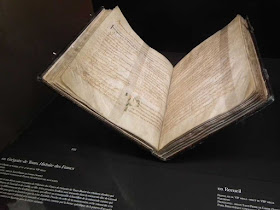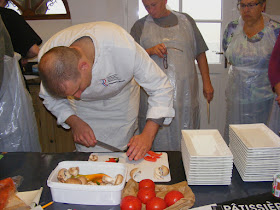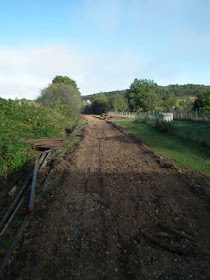The facade of the royal apartments.
Chateau Gaillard is a small royal chateau in Amboise, used by
Charles VIII as a retreat when he returned from the First Italian Wars. It is just up the road from
Clos Lucé and tucked in under the southern cliff face of the limestone spur that the
Chateau-Royal of Amboise sits upon.
This hexagonal staircase tower gives the building away as late medieval rather than wholly renaissance in style.
Construction of the royal apartments which form the main block of the chateau began in 1496. It is the first building in France to be built in the Italian style that the Loire Valley chateaux are famous for. It is also the site of the first renaissance style garden in France, with Italian style parterres that become the iconic French formal style of gardening.
The kennels turned out to currently house a small goat.
In front of the chateau is a generous terrace which looks out onto a 15 hectare park which has been created on boggy land on the banks of the Amasse. The 20 metre cliff behind the chateau means that the valley bowl is protected from the north winds and has its own Mediterannean microclimate.
My American colleagues
Deb and
Charlie walk up the driveway.
The original garden was created by Dom Pacello da Mercoliano, who returned with Charles VIII after his campaigning in Italy, along with a team of 21 other Italian artisans. The site provided ideal conditions, with plentiful water and shelter, that gave it a big advantage over the main Chateau-Royal.
Looking down into the kitchen garden.
Dom Pacello created the first garden in France with a central axis to enhance perspective, the first formal garden beds, defined by low holly hedges, and the first 'mirror pond', fed by the Amasse and a spring on the side of the hill. He introduced citrus, especially lemon and orange trees, to the garden, the very first to come to France. Heated greenhouses were built to house the northern most peaches in France. The greengage plum (Fr. reine-claude) dates from Dom Pacello's time here and was a selection made in this garden. Another innovation was the growing of melons and tomatoes in enclosures with low walls to act as windbreaks.
Different local wine grape varieties grown on a south-east facing slope, with chunks of limestone mulch.
Nowadays in the park there are many grand trees (oaks, cedars, yews, tulip trees, elms, ash, robinia, Judas trees), an arched gateway contemporary with the chateau, an 18th century cottage, grottoes in the cliff as well as a magnificent 350 metre double allée of London Plane forming the 'back' driveway, created in 1885 by Jean Théodore Coupier (industrial chemist and engineer, a former owner of the chateau).
The greenhouse.
In 1505 Louis XII ceded the chateau to Dom Pacello, in return for a rent of 30 sols and a bunch of orange blossom every year. After having been one of the residences of Charles VIII and Anne of Brittany, then Louis XII and Dom Pacello, Chateau Gaillard saw a succession of notables stay within its walls: René de Savoie (François I's uncle) and Anne Lascaris ; Jean III Cardinal de Lorraine; François II and Mary Queen of Scots (on their honeymoon); Charles de Guise-Lorraine (Jean's nephew and also Cardinal, who remodelled the facade of the royal apartments in 1559); René de Villequier (one of Henri III's favourites); the Della Rovere family (Italian nobility whose family included two Popes and the Dukes of Urbino); and André Malraux (de Gaulle's Minister of Cultural Affairs) and Louise de Vilmorin (his mistress, a novelist and heiress to the
Vilmorin seed company fortune). The estate is currently owned by a private property trust headed by
Marc Lelandais.
Espaliered apple trees with chunks of slate used to define the beds and mulch.
In 2009 the chateau was a ruin and it seemed possible that the site would be subdivided. Luckily the mayor of Amboise refused to authorise this and Marc Lelandais was able to purchase the property with a view to restoring it to its former glory. Using private funds only, it took five years, and just as they were about to open fully to the public, in June 2016, they were inundated with flood waters.





















































